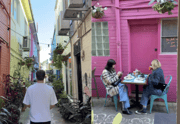This Coffee Cup Trend is Driving Everyone Crazy - Are You Making This Senseless Mistake?
By
Danielle F.
- Replies 16
In the bustling world of coffee aficionados and casual sippers alike, a new trend has emerged that's stirring up quite the controversy. It's a phenomenon that's not only perplexing but also sparking heated debates across the globe, from the cobblestone streets of London to the sun-drenched cafes of Australia. The issue at hand? The increasing use of disposable takeaway cups, even when customers are dining in.
Let's paint the picture: You're at your local café, the aroma of freshly ground coffee beans wafting through the air. You order your favourite brew, perhaps a robust espresso or a creamy cappuccino, and instead of receiving it in a warm, inviting ceramic mug, you're handed a single-use paper cup with a plastic lid. It's a sight that's becoming all too common, and it's leaving many coffee lovers and environmentalists scratching their heads in dismay.
This trend was recently brought to light by environmental entrepreneur James Atkins, who, while on holiday in the UK, observed a curious scene. Patrons were opting for disposable cups despite sitting comfortably inside the café. Atkins, who dedicates his time to pondering the environmental impact of our daily habits, couldn't help but question the logic behind this choice. 'When I saw loads of people sitting down to drink coffee out of takeaway cups, I thought that doesn't make sense,' he expressed to Yahoo News.
Atkins took to LinkedIn to voice his concerns, igniting a fiery discussion that has since captivated over five million café-goers. The post has garnered thousands of reactions and hundreds of comments, revealing a divide in public opinion.
The environmental implications of this trend are significant. Annually, around half a trillion coffee cups are produced, and shockingly, less than one percent are recycled. The majority of these cups are lined with plastic, making them a recycling nightmare and a contributor to the ever-growing piles of waste in our landfills, where they can linger for decades.
Despite the environmental concerns, some individuals defend their preference for single-use cups, citing hygiene as a primary factor. 'It's a hygiene thing for me. I'd sooner have a plastic/paper cup than one which has been in a cafe dishwasher,' one person admitted. Others attribute the trend to our fast-paced, 'on the go' culture, where convenience often trumps sustainability.
Interestingly, in places like Britain, there's a financial incentive to choose disposable over dine-in. A 25 percent value-added tax (VAT) is applied to bills for customers who dine in, leading savvy consumers to order their coffee in a takeaway cup to avoid the extra charge. 'It seems bonkers, and it's something the government could easily fix,' Atkins remarked, understanding the appeal of saving a few pounds in the midst of a cost-of-living crisis.
Beyond the financial and hygienic justifications, there's also a psychological aspect to consider. Atkins suggests that clutching a takeaway cup may signal to others that we're busy and important, ready to dash off to our next pressing engagement at a moment's notice. It's a modern-day status symbol, a marker of a life filled with urgency and significance.
As members of the Seniors Discount Club, we understand the value of taking a moment to slow down and savour life's simple pleasures, like enjoying a coffee in a proper cup. Not only does it taste better, free from the taint of paper and plastic, but it also represents a more mindful and environmentally friendly approach to our daily routines.
So, dear readers, we pose the question: Are you unwittingly contributing to this senseless mistake? Next time you find yourself in a café, consider forgoing the takeaway cup for a ceramic one. It's a small change that can make a big difference, both for the environment and for the quality of your coffee experience. And who knows, you might just find that taking the time to sit and sip from a real cup is the pause in your day that you didn't know you needed.

We'd love to hear your thoughts on this topic. Have you noticed this trend in your local coffee shops? What's your stance on the use of disposable cups when dining in? Share your insights and join the conversation below!
Let's paint the picture: You're at your local café, the aroma of freshly ground coffee beans wafting through the air. You order your favourite brew, perhaps a robust espresso or a creamy cappuccino, and instead of receiving it in a warm, inviting ceramic mug, you're handed a single-use paper cup with a plastic lid. It's a sight that's becoming all too common, and it's leaving many coffee lovers and environmentalists scratching their heads in dismay.
This trend was recently brought to light by environmental entrepreneur James Atkins, who, while on holiday in the UK, observed a curious scene. Patrons were opting for disposable cups despite sitting comfortably inside the café. Atkins, who dedicates his time to pondering the environmental impact of our daily habits, couldn't help but question the logic behind this choice. 'When I saw loads of people sitting down to drink coffee out of takeaway cups, I thought that doesn't make sense,' he expressed to Yahoo News.
Atkins took to LinkedIn to voice his concerns, igniting a fiery discussion that has since captivated over five million café-goers. The post has garnered thousands of reactions and hundreds of comments, revealing a divide in public opinion.
The environmental implications of this trend are significant. Annually, around half a trillion coffee cups are produced, and shockingly, less than one percent are recycled. The majority of these cups are lined with plastic, making them a recycling nightmare and a contributor to the ever-growing piles of waste in our landfills, where they can linger for decades.
Despite the environmental concerns, some individuals defend their preference for single-use cups, citing hygiene as a primary factor. 'It's a hygiene thing for me. I'd sooner have a plastic/paper cup than one which has been in a cafe dishwasher,' one person admitted. Others attribute the trend to our fast-paced, 'on the go' culture, where convenience often trumps sustainability.
Interestingly, in places like Britain, there's a financial incentive to choose disposable over dine-in. A 25 percent value-added tax (VAT) is applied to bills for customers who dine in, leading savvy consumers to order their coffee in a takeaway cup to avoid the extra charge. 'It seems bonkers, and it's something the government could easily fix,' Atkins remarked, understanding the appeal of saving a few pounds in the midst of a cost-of-living crisis.
Beyond the financial and hygienic justifications, there's also a psychological aspect to consider. Atkins suggests that clutching a takeaway cup may signal to others that we're busy and important, ready to dash off to our next pressing engagement at a moment's notice. It's a modern-day status symbol, a marker of a life filled with urgency and significance.
As members of the Seniors Discount Club, we understand the value of taking a moment to slow down and savour life's simple pleasures, like enjoying a coffee in a proper cup. Not only does it taste better, free from the taint of paper and plastic, but it also represents a more mindful and environmentally friendly approach to our daily routines.
So, dear readers, we pose the question: Are you unwittingly contributing to this senseless mistake? Next time you find yourself in a café, consider forgoing the takeaway cup for a ceramic one. It's a small change that can make a big difference, both for the environment and for the quality of your coffee experience. And who knows, you might just find that taking the time to sit and sip from a real cup is the pause in your day that you didn't know you needed.
Key Takeaways
- A photograph taken at a London High Street café has caused an uproar over the use of single-use takeaway coffee cups by customers sitting inside the establishment.
- Environmental entrepreneur James Atkins sparked a heated debate on LinkedIn regarding the unnecessary waste created by these disposable cups and people's preference for them over ceramic cups for dine-in experiences.
- Respondents to Atkins' post offered various reasons for choosing single-use cups, including hygiene concerns, the insulating properties of disposable cups, the cost-saving aspect due to VAT, and the on-the-go culture.
- There is a psychological aspect to choosing takeaway cups with some perceiving it as a sign of a busy and important lifestyle; Atkins suggests taking time to enjoy coffee from a proper cup is better for personal well-being and the environment.








